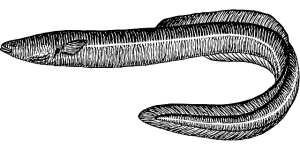Eels from North American and European rivers travel out into the Atlantic and swim south, to the Sargasso Sea. It is an immense patch of water in the tropical Atlantic Ocean, between Bermuda and the West Indies, which is filled with a variety of seaweed and small creatures.
Arriving there, the eels know exactly what to do. Going to a depth of 1300 to 2500 feet, they lay their eggs and then leave. The parents die without ever seeing their young.
Because of where the eggs were laid, the young are gradually carried eastward at a depth of 700 feet into the Gulf Stream. Northward it takes them, and on and on they go.
Arriving at the northeastern U.S., half the eels head west and journey up American rivers into the the Great Lakes to localities where their parents formerly resided.
The others continue swimming with the Gulf Current until they are off the coast of Europe. As do the American eels, when they arrive at the edge of the continental shelf, which maybe several hundred miles from the coast, their bodies begin changing. Until now, they have not needed complicated swimming gear; for they were carried along by the Gulf Current. But now, at just the right time, their bodies changed – narrowing, shrinking a little, and growing pectoral fins. Soon they look like their parents, but a little smaller and more transparent.
As soon as this change is completed, the eels stop eating and head directly to the European rivers. Some go into Britain, others into the Baltic, still others up the rivers of France, and others go through the Straits of Gibraltar into the Mediterranean. Some go all the way to the Black Sea.
These saltwater fish now swim up freshwater rivers unnoticed by most predators, because they are almost transparent. After several months, they have arrived at their parents’ home, and they begin feeding again.
Now they grow to full size and opaque appearance, with yellow backs and sides. After several years (3 for males, 8 or 9 for females), their eyes enlarge, for they will now need sharper vision as they head back to the sea. If necessary, they are known to crawl around waterfalls and across dew-drenched fields.
Tracked by scientists, reaching the ocean they swim at a depth of 200 feet toward the northwest until they reach the continental shelf. Then they quickly dive to about 1400 feet. Six months later, attached radios show that they have arrived back at the Sargasso Sea – 3500 miles from where they started.


Leave a Reply